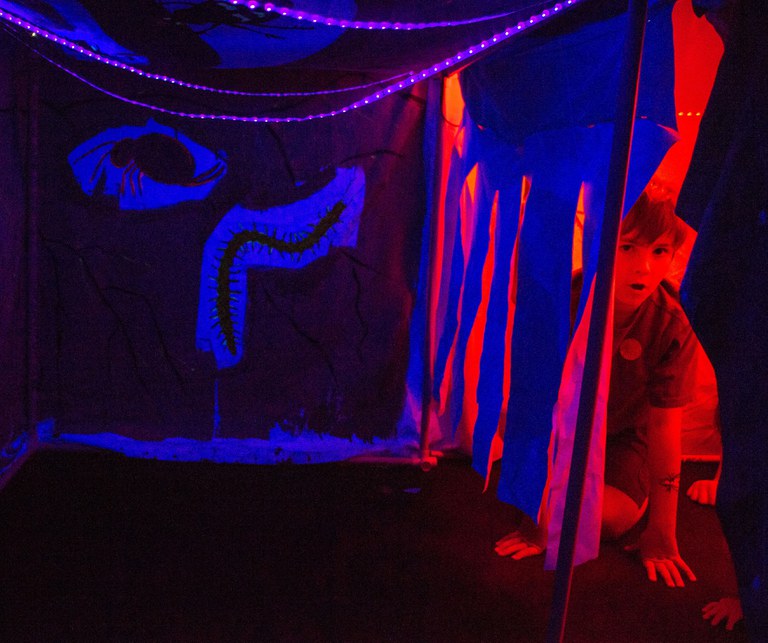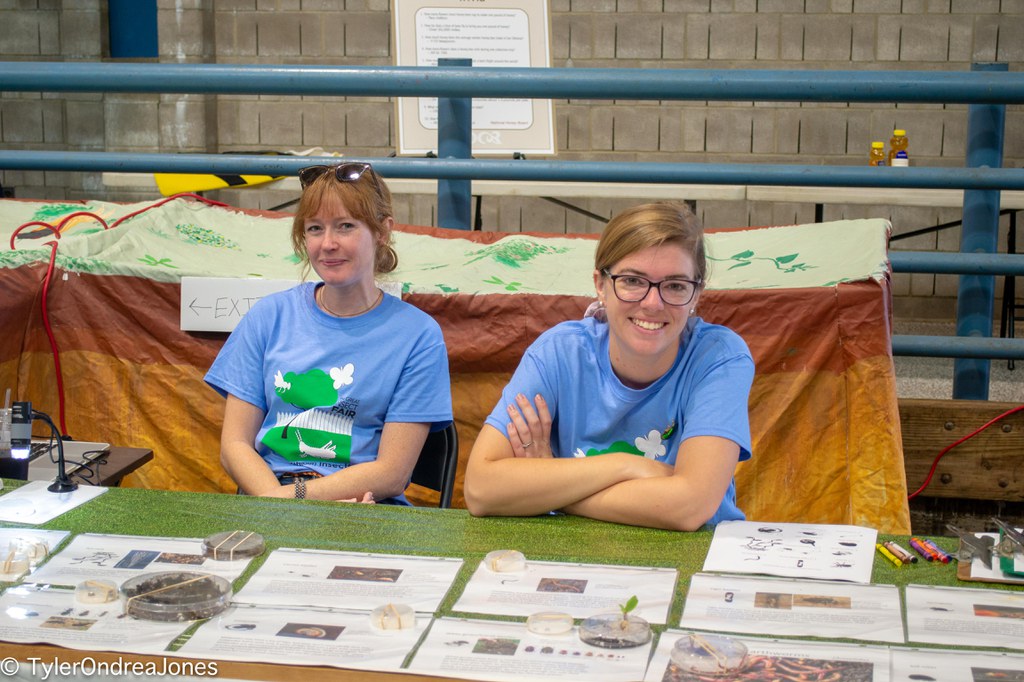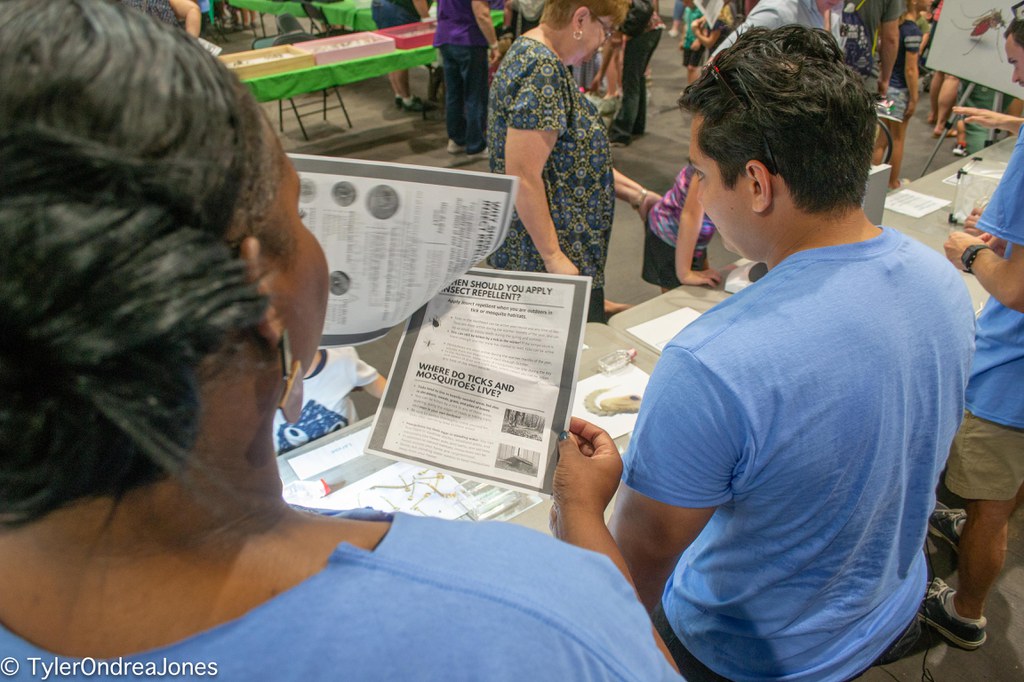Posted: October 10, 2019
Penn State Entomology graduate students were able to bring aspects of their research to the public at the annual Great Insect Fair (GIF). Located in the Snider Agricultural Arena, the GIF theme for 2019 was “A world with(out) insects” and students were able to showcase what our world would look like without some key critters and certainly what outreach efforts look like with graduate students at the forefront.

Inside the Haunted Soils. A 2019 PSU Great Insect Fair participant can be seen crawling through the tunnels. They are about to uncover a glow-in-the-dark collembollan and centipede. Photo by Tyler Ondrea Jones
Of the 30+ educational booths at the Great Insect Fair, seven are organized and staffed by the Entomology Graduate Student Association (EGSA) including main attractions -- and yearly favorites -- such as the Insect Zoo and the Butterfly and Nocturnal Insect Tents. In addition to the EGSA booths at the Great Insect Zoo, graduate students are the main volunteers and contributors for many of the booths that are based on Penn State Entomology research areas.

PSU Graduate students Elizabeth Rowen (right) and Liz Davidson-Lowe (left) sitting outside of the "Haunted Soils" Exhibit at the 2019 Great Insect Fair.
Makaylee Crone, second year PhD candidate in Ecology, is currently investigating how nutrition impacts solitary bee pesticide resistance. On her role coordinating the butterfly tent with fellow Entomology Graduate student, John Elmquist, she says, "I didn't realize how much goes into outreach and planning events like the Great Insect Fair before this experience. As students, we have a lot greater responsibility than I thought we did." Additionally, Crone said that caring about outreach is important to creating a good experience, "I think it goes into more thought-out outreach… making sure people get something out of it."
A recent survey on the public's trust of scientists (Pew Research Center 2019) has shown that confidence in scientists increases as the public gains more factual science knowledge. Scientific outreach such as the Great Insect Fair, which has entertained and educated up to 6,500 individuals in the past (Milazzo 2013), is an avenue for Penn State scientists to forge connections with the public and bolster that public trust.
The Great Insect Fair is a fast-paced affair that gives an opportunity to bring aspects of Penn State research to the public in high-impact bite-sized chunks. Fhallon Ware-Gilmore, third year PhD candidate in the McGraw Lab, has taken this opportunity to connect the public with mosquito biology, ecology, disease prevention, and public health associated with common mosquitos in Pennsylvania.

PSU Graduate students Fhallon Ware-Gilmore (left) and Mario Novelo Canto (right) heading the "Mosquito Biology" booth at the 2019 PSu Great Insect Fair. Ware-Gilmore can be seen flipping through a fact sheet on vector control that includes updated information on mosquito-vectored diseases and how to prevent them.
A main draw to the McGraw Lab table is the cage full of male yellow fever mosquitos that visitors can put their hand in and walk away unscathed and not itchy -- a testament to the fact that male mosquitos do not bloodfeed -- they are primarily sugar and nectar feeders. It is in fact the females who transit most mosquito-borne pathogens as they bounce from an infected blood meal to a new host searching for their next blood meal.

Young Great Insect Fair participant tests whether male mosquitoes really don't bite. Spoiler Alert: they do not.
When asked how her own research ties into the "Living with(out) insects" theme, Ware-Gilmore says, "mosquitos fill an important ecological niche." Indeed, while mosquitos may not be everyone's favorite, it is vital to understand how they interact with the organisms they feed from and the disease causing pathogens they transmit such as West Nile Virus and Eastern Equine Encephalitis (EEE) virus.
One of the biggest things Ware-Gilmore hoped GIF participants got out of the McGraw Lab table was knowledge. "mosquitos transmit more disease causing pathogens than any other animal in the world," says Ware-Gilmore. "The hands-on activities at GIF are impactful because they give the adults experience with, for example, what mosquito larvae or eggs look like so they can better control the populations around their homes, and it introduces the kids to entomology and helps harbor an overall love for entomology."
Elizabeth Rowen, a Tooker Lab fifth year PhD student, has used the Great Insect Fair to make and lead the "Haunted Soils" exhibit - "an experience for kids to see life underground" -- beetles and ground-nesting bees are among the collection of glow-in-the-dark options that have been a part of the exhibit for the last three years.
Her own research follows how pesticides affect soil ecosystems, particularly soil-dwelling pests and predators. With this year's theme on living with and without insects, the "Haunted Soils" exhibit was a testament to how soils change in the face of insect biodiversity loss and how humans are affecting soil through pesticide use and disturbance and how people can increase the habitat potential of soil. "I want to give a sense of soil as a habitat as rich and diverse as a tree or anything they can see above ground," says Rowen. In studying soil and soil management practices, Rowen has found that "almost everything is connected to soil," and that the Great Insect Fair is an opportunity to "connect people to insects."
When asked about her parting message to the community (apt as this is likely the last year for the Haunted Soils Exhibit as well as Rowen's last GIF before she graduates in 2020) she responds, "Soil is important, and beautiful, and amazing and everyone should dig a hole and look through it and see what insects they can find because it is so FUN!"
Ware-Gilmore ends her seven-hour marathon of outreach at the Great Insect Fair with the following, "The good thing about outreach is that we can give people the most accurate and up-to-date information and advice. I love engaging with the community about a topic I'm interested in. I like sharing that information, and I think the main goal of GIF is that it connects academia and the community. Outreach allows us to impactfully engage with the community. and that's what I love about outreach and our department's commitment to it."
Certainly, it seems that a world without graduate students passionate about bringing science to the public would be a huge loss to the community at large.
Tyler O. Jones
Twitter @melliferocity
Follow more of Penn State Entomology on Twitter @PSU_Entomology
Students highlighted in this article: Fhallon Ware-Gilmore (@MozzieFhal), Makaylee Crone (@MakayleeCrone), and Elizabeth Rowen (@zabfieldRowen)

